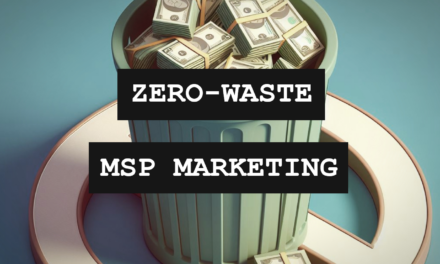Grow Margins and Increase Retention By Adding More Value To Your VoIP Offering
As an MSP that once sold white-labelled VoIP service, I understand the challenges that many will face getting this service offering fully integrated into their tech stack. Our approach (which I now realize was not ideal) was essentially to generate a high volume of VoIP sales regardless of our profit margin, simply to reach the highest partner tier that we could. We thought that if we had our customers under contract, it would be easy to retain the business over the length of our IT contract and thus this would essentially become passive income over time.
What I now realize is that this strategy left so much on the table. We tried to over-simplify the offering and compete on price, but in reality this was just a way to mask our lack of product-knowledge. As soon as we experienced outages or carrier-level issues, our VoIP customers already had one foot out the door, primarily because we had not established legitimate value around these offerings and relied solely on our price point and existing relationship to seal the deal.
If I were to start selling these services again right now, my focus would be almost solely on features and integrations as a way to build a high retention service offering. I would look to build communication bridges between as many systems as possible in a way that dramatically increased the value of all of those services to the end customer.
I recently brought up this concept to George Bardissi, CEO of BVoIP as we talked about how some of their most successful partners are leveraging features and integrations to achieve growth. I also wanted to get his expert opinion on working this into the MSP sales process to close new prospects. Tune in to our conversation below:

BVoIP Offers MSPs Flexible, Reliable, and Creative Cloud Unified Communication Solutions To Grow Their Business. Request Demo
From this conversation I began to document what my approach would be to not only increase the value to my existing VoIP customers, but also to leverage these relationships to increase the closing ratio on new appointments. Here are a few areas of emphasis that I believe are of utmost importance when leveraging features and integrations to sell VoIP:
Learn Your Customer’s Systems & Processes
The act of fully integrating a streamlined communication system begins and ends with your customer. For you to genuinely improve their workflow, you need to have a thorough understanding of how they communicate both internally and externally (with customers) at each touchpoint and which systems they use to do so. While some of these systems may be tailored to their industry (and not all that common) that is actually a good thing. This will help you later on as you fold this into your sales and marketing strategy.
I would recommend setting aside a minimum of 30 minutes per week to meet with an existing VoIP customer to do a “re-discovery” of their workflow in every department possible. For example, when a potential customer clicks on an advertisement and calls their company, what happens? Who’s phone rings, what systems/ CRMs do they input the information into, and then what type of communications are required to turn that lead into a customer? What you will find, is that there is always room for some kind of improvement (such as smart call routing to a Salesperson based on CRM assignment) and VoIP is likely the backbone for these connections to occur.
Work W/ VoIP Provider On Deep Integration
If you don’t have an in-house or outsourced software developer that can work on such integration projects then don’t be discouraged. Most VoIP providers will entertain the idea of building you an integration into a system themselves if it can help their other partners as well. This is also the downside of this approach, as there is not likely to be any exclusivity (as you would if you custom-developed) and the integration could very well be used by your competitors as well.
Nevertheless, work together to build as deep of an integration as possible into the customer’s systems. The more improved their workflow becomes, the more value you are building toward your service offering. This now becomes way more than a “phone system” and it will be increasingly difficult for your customer to compare what you are offering to anything else on the market. This is the kind of leverage that will help you grow your margins and increase retention in the process.

BVoIP Offers MSPs Flexible, Reliable, and Creative Cloud Unified Communication Solutions To Grow Their Business. Request Demo
Target New Prospects With Similar Requirements
Once you are able to get your customers utilizing their VoIP systems at a high capacity, you will begin to learn what is at the core of their satisfaction and how you can use that attract net-new customers as well. I always got excited when our MSP did a great job of solving a very specific problem because it opened the door to offering contextually relevant solutions to other like companies with similar issues.
For example, if you are able to improve how a Hair Salon takes scheduling calls and books appointments within their salon management software, then chances are that you can find other Salons with the same problems that could benefit from the same solution. Having just solved this problem already for another customer, you now have a clear and obvious “talk track” that these prospects can relate to and your experience now helps to reduce their risk and speed up the sales cycle.
Develop A Strong & Unique Call-To-Action
Once you have officially pulled off a “rinse and repeat” of a vertical specific feature integration, you can start to develop more concrete sales messaging around this concept. As I stated in my conversation with George, I would start to build content in the form of videos, blogs, and social media posts showing off these upgraded systems and what they can do.
LinkedIn and Facebook are both great platforms to post this content and each offer the ability to target ads by industry and job title. If we use the previous example of a Hair Salon, you could then post a video showing how this third party Salon Management software can be better integrated to reduce both the booking time and appointment cancellations. You can then offer a “free demo” or similar scheduled presentation as your primary call-to-action which will perform far better than simply asking your visitors to “contact us.”

SPONSORED BY ZEST
















